Users’ Perception of Value of Travel Time and Value of Ridesharing Impacts on Europeans’ Ridesharing Participation Intention: A Case Study Based on MoTiV European-Wide Mobility and Behavioral Pattern Dataset
Abstract
1. Introduction
2. Literature Review
2.1. Internal Factors
2.2. External Factors
3. Research Method
3.1. Data Collection and Sample Description
3.2. Modeling Methodology
4. Results
4.1. Descriptive Statistics (Data Analysis of the Factors Influencing Choice of Ridesharing)
4.2. Analysis of Differences in Individuals’ Intentions Towards Ridesharing in Four EU Countries
5. Discussion
5.1. Effects of Exogenous Factors
- Gender: with regards to individuals’ characteristics, being female was not a significant predictor to participate in available ridesharing options.
- Age: respondents age, as we expected, was not significant predictor for choosing ridesharing. For instance, multinomial log-odds of people in age range of 16–24 years is 2.99 unit higher for preferring to choose ridesharing with strangers given other ridesharing choices which means youths in participant countries are more likely to prefer to share a ride with someone they know or even a stranger compared to having the possibility to share a ride with family members.
- Household size: the results demonstrate that household size has a negative significant impact on choosing ridesharing with family members and others. Results indicate that people from households with three persons tend to select less ridesharing with someone they already know compared to other ridesharing choices such as with family members and even strangers.
- Urban size: the built environment and residing in medium city is significant predictor for being interested in shared rides with others. According to the results, it can be interpreted that people in medium cities, compared to small and metropolitan cities citizens, are more likely willing to participate in a ridesharing with someone they know.
- Country of residence: the country of residence as a categorical variable was modeled for four groups of citizens in Spain, Finland, Portugal, and Slovakia. Based on the results, it can be interpreted that residence location has no significant impact on participation in ridesharing with family members and someone that respondents already know. On the other hand, analysis results reveal a high tendency of sharing a taxi among Finnish people compared to Spanish, Portuguese, and Slovak citizens.
- Years of residence: respondents’ years of residence in the participant countries has a negative significant impact on their intention to use ridesharing with family or friends and someone they know compared to those people who would probably be willing for sharing ride with strangers. It means people with increasing their years of residency will more likely be less interested to share ride with family members or friends.
5.2. Effects of Endogenous Factors
- Trip purpose: obtained results reveal that among the trip purposes associated to people’s preference for ridesharing, work trip has a positive impact on sharing a ride. This demonstrates that work trip purpose has the highest propensity among people for sharing rides with family and friends and even strangers compared to those people who showed that thay are not interested in participating in any type of ridesharing.
- Time of day: according to the results, the most preferred time periods for shared rides with family and friends are weekends and mornings of working days. When it comes to sharing a taxi or a ride with someone they know results show that people are willing to share rides any time during weekdays and weekends. Concerning ridesharing with strangers, results also indicate that high tendency among people for useing ridesharing is during weekends.
- Perceived value of travel time: among three core values of users’ perception of travel time worthwhileness, enjoyment value has a positive significant influence on individuals’ preference for choosing ridesharing for daily commuting. Results reveal that those people who have higher expectation of enjoyment during travel time are more likely to use a taxi for ridesharing even with strangers.
- Perceived value of ridesharing: regarding individuals’ expected value of ridesharing, it can be figured out from the results that helping and meeting people (i.e., enjoyment of being social) is a significant motivation for respondents to choose a taxi for ridesharing which is consistent with Burkhardt and Millard-Ball [58] findings.
- Acceptable TT increase: according to the results, people who are interested in participating in ridesharing options are expecting more likely an increase of 15–30 min in their travel time, in particular when they tend to share a ride with someone they know.
6. Conclusions
Author Contributions
Funding
Acknowledgments
Conflicts of Interest
References
- Rong, K.; Xiao, F.; Wang, Y. Redundancy in the sharing economy. Resour. Conserv. Recycl. 2019, 151, 104455. [Google Scholar] [CrossRef]
- Yuana, S.L.; Sengers, F.; Boon, W.; Raven, R. Framing the sharing economy: A media analysis of ridesharing platforms in Indonesia and the Philippines. J. Clean. Prod. 2019, 212, 1154–1165. [Google Scholar] [CrossRef]
- The Use of the Collaborative Economy 2018. Available online: https://op.europa.eu/en/publication-detail/-/publication/34eb3c1f-cb6f-11e8-9424-01aa75ed71a1 (accessed on 14 January 2020).
- Machado, C.A.S.; Hue, N.P.M.; Berssaneti, F.T.; Quintanilha, J.A. An overview of shared mobility. Sustainability 2018, 10, 4342. [Google Scholar] [CrossRef]
- Shared Mobility Definitions. Available online: https://www.transit.dot.gov/regulations-and-guidance/shared-mobility-definitions (accessed on 14 January 2020).
- Jiao, J.; Bischak, C.; Hyden, S. The impact of shared mobility on trip generation behavior in the US: Findings from the 2017 national household travel survey. Travel Behav. Soc. 2020, 19, 1–7. [Google Scholar] [CrossRef]
- Eurostat: Passenger Cars in the EU. Available online: https://ec.europa.eu/eurostat/statistics-explained/index.php?title=Passenger_cars_in_the_EU&oldid=438653#Overview (accessed on 14 January 2020).
- Deloitte: The Rise of the Sharing Economy. Available online: https://www2.deloitte.com/content/dam/Deloitte/us/Documents/consumer-business/us-cb-the-rise-the-sharing-economy.pdf (accessed on 14 January 2020).
- Delitheou, V.; Bakogiannis, E.; Kyriakidis, C. Urban planning: Integrating smart applications to promote community engagement. Heliyon 2019, 5, e01672. [Google Scholar] [CrossRef]
- Attard, M.; Haklay, M.; Capineri, C. The potential of Volunteered Geographic Information (VGI) in future transport systems. Urban Planing 2016, 1, 6–19. [Google Scholar] [CrossRef]
- Kováčiková, T.; Lugano, G.; Pourhashem, G. From travel time and cost savings to value of mobility. In Proceedings of the 17th International Multi-Conference “Reliability and Statistics in Transportation and Communication” (RelStat 2017), Riga, Latvia, 18–21 October 2017; pp. 35–43. [Google Scholar]
- Lugano, G.; Kurillova, Z.; Hudák, M.; Pourhashem, G. Beyond travel time savings: Conceptualizing and modelling the individual value proposition of mobility. In Proceedings of the 4th Conference on Sustainable Urban Mobility, Skiathos Island, Greece, 24–25 May 2018. [Google Scholar]
- Wang, Y.; Gu, J.; Wang, S.; Wang, J. Understanding consumers’ willingness to use ride-sharing services: The roles of perceived value and perceived risk. Transp. Res. Part C Emerg. Technol. 2019, 105, 504–519. [Google Scholar] [CrossRef]
- Prieto, M.; Baltas, G.; Stan, V. Car sharing adoption intention in urban areas: What are the key, sociodemographic drivers? Transp. Res. Part A Policy Pract. 2017, 101, 218–227. [Google Scholar] [CrossRef]
- Ballus-Armet, I.; Shaheen, S.; Clonts, K.; Weinzimmer, D. Peer-to-peer carsharing: Exploring public perception and market characteristics in the San Francisco Bay Area. Transp. Res. Rec. J. Transp. Res. 2014, 2416, 27–36. [Google Scholar] [CrossRef]
- Payyanadan, R.P.; Lee, J.D. Understanding the ridesharing needs of older adults. Travel Behav. Soc. 2018, 13, 155–164. [Google Scholar] [CrossRef]
- Amirkiaee, S.Y.; Evangelopoulos, N. Why do people rideshare? An experimental study. Transp. Res. Part F Traffic Psychol. Behav. 2018, 55, 9–24. [Google Scholar] [CrossRef]
- Cheyne, C.; Imran, M. Shared transport: Reducing energy demand and enhancing transport options for residents of small towns. Energy Res. Soc. Sci. 2016, 18, 139–150. [Google Scholar] [CrossRef]
- TCRP Research Report: Shared Mobility and the Transformation of Public Transit. Available online: http://www.trb.org/Main/Blurbs/174653.aspx (accessed on 14 January 2020).
- Bahat, O.; Bekhor, S. Incorporating ridesharing in the static traffic assignment model. Netw. Spat. Econ. 2016, 16, 1125–1149. [Google Scholar] [CrossRef]
- Ciari, F. Why do people carpool? Results from a Swiss survey. In Proceedings of the Swiss Transport Research Conference, Monte Verità, Ascona, Switzerland, 2–4 May 2012. [Google Scholar]
- Wang, Y.; Winter, S.; Tomko, M. Collaborative activity-based ridesharing. J. Transp. Geogr. 2018, 72, 131–138. [Google Scholar] [CrossRef]
- Arbour-Nicitopoulos, K.; Faulkner, G.E.J.; Buliung, R.N.; Lay, J.; Stone, M. The school run: Exploring carpooling as an intervention option in the Greater Toronto and Hamilton Area (GTHA), Canada. Transp. Policy 2012, 21, 134–140. [Google Scholar] [CrossRef]
- Delhomme, P.; Gheorghiu, A. Comparing French carpoolers and non-carpoolers: Which factors contribute the most to carpooling? Transp. Res. Part D Transp. Environ. 2016, 42, 1–15. [Google Scholar] [CrossRef]
- Li, J.; Embry, P.; Mattingly, S.P.; Sadabadi, K.F.; Rasmidatta, I.; Burris, M.W. Who Chooses to Carpool and Why? Examination of Texas Carpoolers. Transp. Res. Rec. J. Transp. Res. Board 2007, 2021, 110–117. [Google Scholar] [CrossRef]
- Vanoutrive, T.; Van De Vijver, E.; Van Malderen, L.; Jourquin, B.; Thomas, I.; Verhetsel, A.; Witlox, F. What determines carpooling to workplaces in Belgium: Location, organisation or promotion? J. Transp. Geogr. 2012, 22, 77–86. [Google Scholar] [CrossRef]
- Cervero, R. Paratransit in America: Redefining Mass Transportation; Green-wood Publishing Group: Westport, CT, USA, 1997. [Google Scholar]
- Rayle, L.; Dai, D.; Chan, N.; Cerveo, R.; Shaheen, S. Just a better taxi? A survey-based comparison of taxis, transit, and ridesourcing services in San Francisco. Transp. Policy 2016, 45, 168–178. [Google Scholar] [CrossRef]
- Contreras, S.D.; Paz, A. The effects of ride-hailing companies on the taxicab industry in Las Vegas, Nevada. Transp. Res. Part A 2018, 115, 63–70. [Google Scholar] [CrossRef]
- Caulfield, B. Estimating the environmental benefits of ride-sharing: A case study of Dublin. Transp. Res. Part D 2009, 14, 527–531. [Google Scholar] [CrossRef]
- Ma, R.; Zhang, H.M. The morning commute problem with ridesharing and dynamic parking charges. Transp. Res. Part B Methodol. 2017, 106, 345–374. [Google Scholar] [CrossRef]
- Hartman, I.B.; Keren, D.; Dbai, A.A.; Cohen, E.; Knapen, L.; Yasar, A.; Janssens, D. Theory and practice in large carpooling problems. Procedia Comput. Sci. 2014, 32, 339–347. [Google Scholar] [CrossRef]
- Van der Waerden, P.; Lem, A.; Schaefer, W. Investigation of factors that stimulate car drivers to change from car to carpooling in city center oriented work trips. Transp. Res. Procedia 2015, 10, 335–344. [Google Scholar] [CrossRef]
- Li, R.; Liu, Z.; Zhang, R. Studying the benefits of carpooling in an urban area using automatic vehicle identification data. Transp. Res. Part C Emerg. Technol. 2018, 93, 367–380. [Google Scholar] [CrossRef]
- Ou, H.; Tang, T.Q. Impacts of carpooling on trip costs under car-following model. Phys. A Stat. Mech. Appl. 2018, 505, 136–143. [Google Scholar] [CrossRef]
- Yu, B.; Ma, Y.; Xue, M.; Tang, B.; Wang, B.; Yan, J.; Wei, M. Environmental benefits from ridesharing: A case of Beijing. Appl. Energy 2017, 191, 141–152. [Google Scholar] [CrossRef]
- Bachmann, F.; Hanimann, A.; Artho, J.; Jonas, K. What drives people to carpool? Explaining carpooling intention from the perspectives of carpooling passengers and drivers. Transp. Res. Part F Traffic Psychol. Behav. 2018, 59, 206–268. [Google Scholar] [CrossRef]
- Bulteau, J.; Feuillet, T.; Dantan, S. Carpooling and carsharing for commuting in the Paris region: A comprehensive exploration of the individual and contextual correlates of their uses. Travel Behav. Soc. 2019, 16, 77–87. [Google Scholar] [CrossRef]
- Neoh, J.G.; Chipulu, M.; Marshall, A. What encourages people to carpool? An evaluation of factors withmeta-analysis. Transportation 2017, 44, 423–447. [Google Scholar] [CrossRef]
- Olsson, L.E.; Maier, R.; Friman, M. Why do they ride with others? Meta-analysis of factors influencing travelers to carpool. Sustainability 2019, 11, 2414. [Google Scholar] [CrossRef]
- Zhang, Y.; Zhang, Y. Examining the relationship between household vehicle ownership and ridesharing behaviors in the United States. Sustainability 2018, 10, 2720. [Google Scholar] [CrossRef]
- Neoh, G.; Chipulu, M.; Marshall, A.; Tewkesbury, A. How commuters’ motivations to drive relate to propensity to carpool: Evidence from the United Kingdom and the United States. Transp. Res. Part A Policy Pract. 2018, 110, 128–148. [Google Scholar] [CrossRef]
- Chaube, V.; Kavanaugh, A.L.; Perez-Quinones, M.A. Leveraging social networks to embed trust in rideshare programs. In Proceedings of the 43rd Hawaii International Conference on System Sciences, Honolulu, HI, USA, 5–8 January 2010; pp. 1–8. [Google Scholar]
- Birgillito, G.; Rindone, C.; Vitetta, A. Passenger mobility in a discontinuous space: Modelling access/egress to maritime barrier in a case. J. Adv.Transp. 2018, 2018, 1–13. [Google Scholar] [CrossRef]
- Tabachnick, B.G.; Fidell, L.S.; Osterlind, S.J. Using Multivariate Statistics; Pearsons: New York, NY, USA, 2001. [Google Scholar]
- Koppelman, F.S.; Sethi, V. Closed-form discrete-choice models. In Hand Book Transport Modeling; Hensher, D.A., Button, K.J., Eds.; Elsevier Science Ltd.: Amsterdam, The Netherlands, 2000; pp. 211–227. [Google Scholar]
- Ben-Akiva, M.; Bierlaire, M. Discrete choice methods and their applications to short term travel decisions. In Handbook of Transportation Science. International Series in Operations Research & Management Science; Springer: Boston, MA, USA, 1999; Volume 23. [Google Scholar]
- Ben-Akiva, M.; Lerman, S.R. Discrete Choice Analysis Theory and Application to Travel Demand; MIT Press: Cambridge, UK, 1985. [Google Scholar]
- Cascetta, E. Travel-demand Models’ in Panos. In Transportation Systems Analysis: Models and Applications; Pardalos, M., Du, D.-Z., Eds.; Springer: Berlin/Heidelberg, Germany, 2009. [Google Scholar]
- Schwab, J.A. Multinomial Logistic Regression: Basic Relationships and Complete Problems; The University of Texas in Austin: Austin, TX, USA, 2002. [Google Scholar]
- Lee, B.H.-Y.; Aultman-Hall, L.; Coogan, M.; Adler, T. Rideshare mode potential in non-metropolitan areas of the northeastern United States. J. Transp. Land Use 2015, 9. [Google Scholar] [CrossRef]
- Silvis, J.; Niemeier, D. Social network and dwelling characteristics that influence ridesharing behavior of seniors. Transp. Res. Rec. 2009, 2118, 47–54. [Google Scholar] [CrossRef]
- Kaufman, S. Why people (don’t) carpool and change for the better. In Proceedings of the Second International Conference on Sustainable Campuses, Melbourne, Australia, 2–4 October 2002. [Google Scholar]
- Hartgen, D. Ridesharing Behavior: A Review of Recent Findings; Preliminary Research Report 130; New York State Department of Transportation: Albany, NY, USA, 1977. [Google Scholar]
- Efthymiou, D.; Antoniou, C.; Waddell, P. Factore affecting the adoption of vehicle sharing systems by young drivers. Transp. Policy 2013, 29, 64–73. [Google Scholar] [CrossRef]
- Bucher, E.; Fieseler, C.; Lutz, C. What’s mine is yours (for a nominal fee)—Exploring the spectrum of utilitarian to altruistic motives for Internetmediated sharing. Comput. Hum. Behav. 2016, 62, 316–326. [Google Scholar] [CrossRef]
- Shumaker, S.A.; Brownell, A. Toward a theory of social support: Closing conceptual gaps. J. Soc. Issues 1894, 40, 11–36. [Google Scholar] [CrossRef]
- Burkhardt, J.; Millard-Ball, A. Who is attracted to carsharing? Transp. Res. Rec. J. Transp. Res. Board 2006, 98–105. [Google Scholar] [CrossRef]
- Mogilner, C.; Norton, M.I. Time, money, and happiness. Curr. Opin. Psychol. 2016, 10, 12–16. [Google Scholar] [CrossRef]
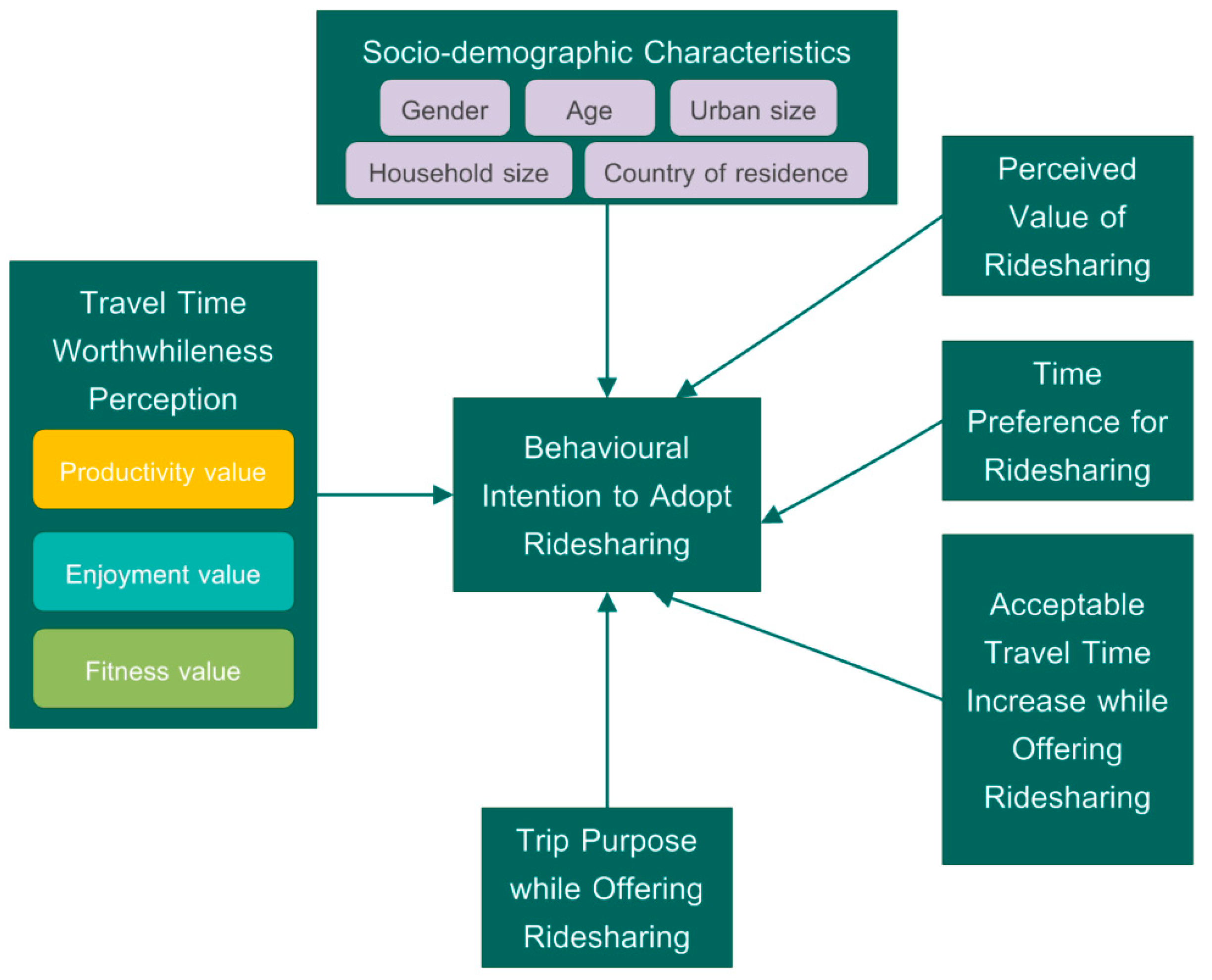
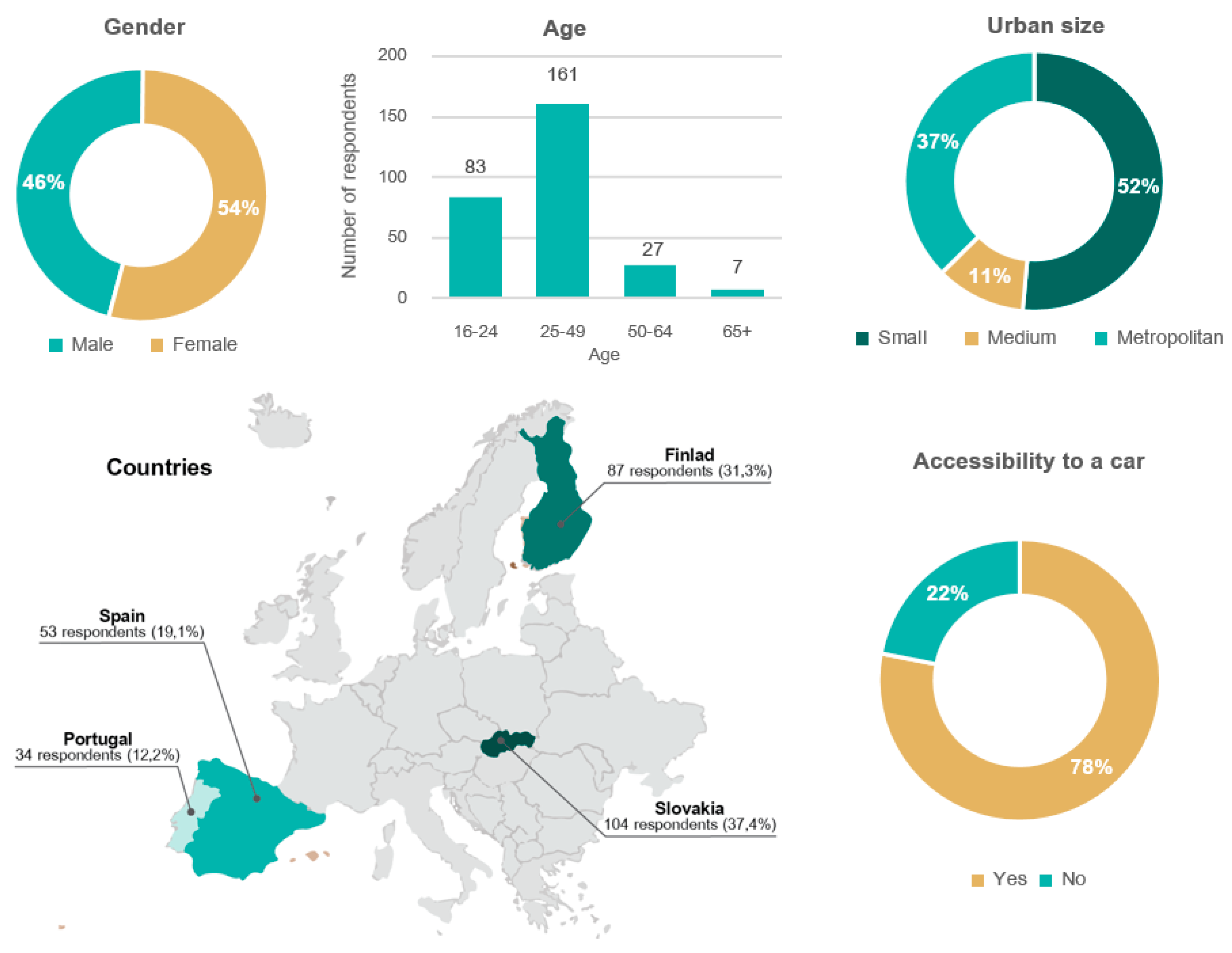
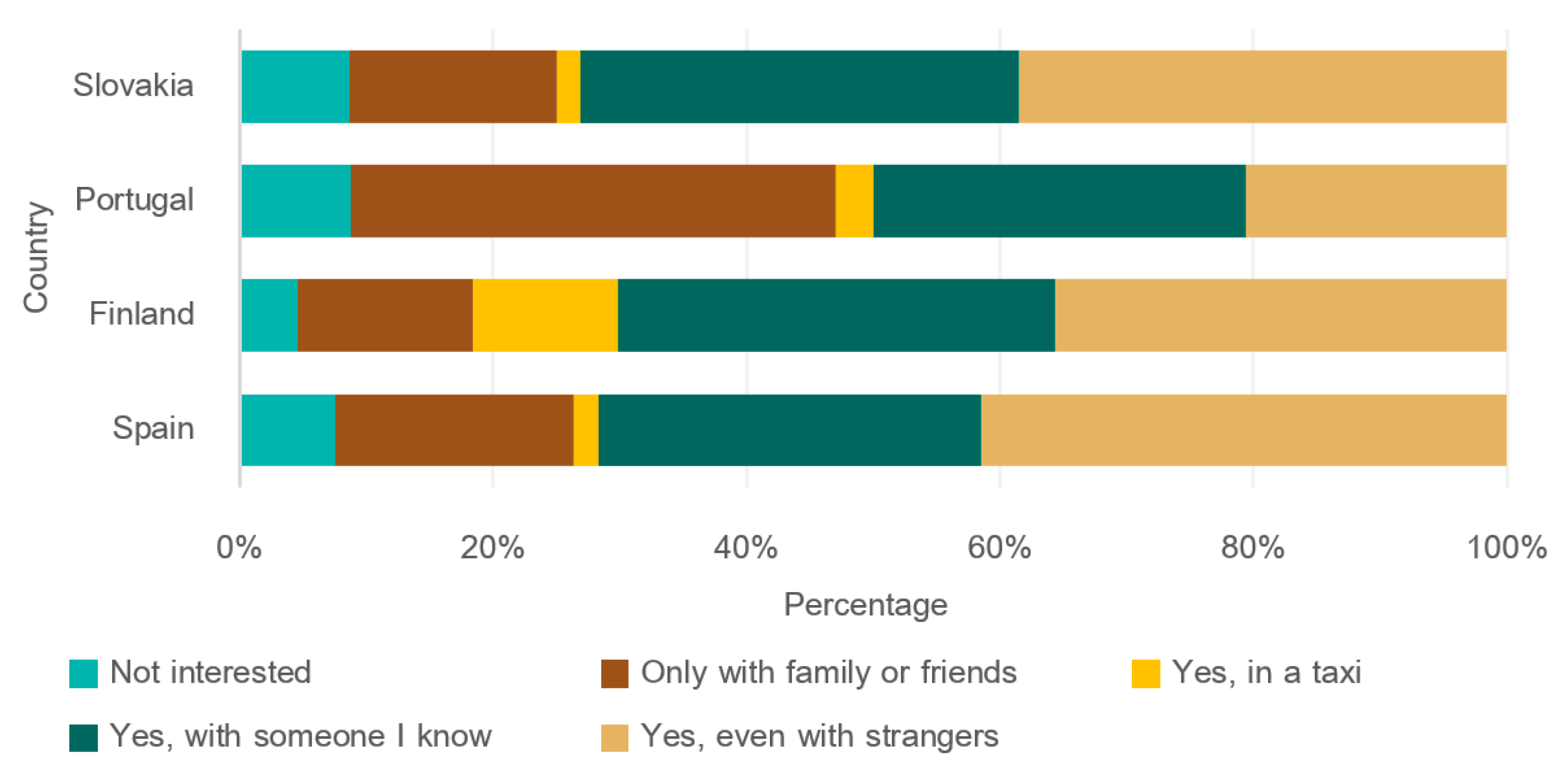
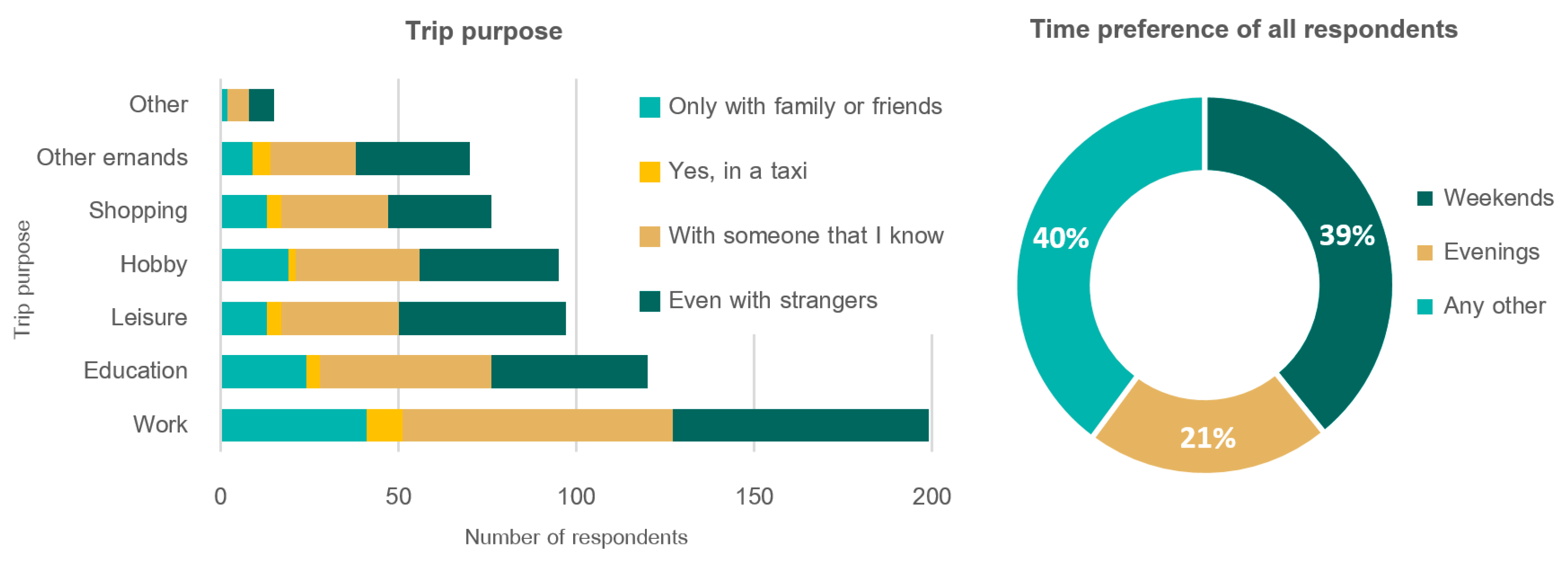
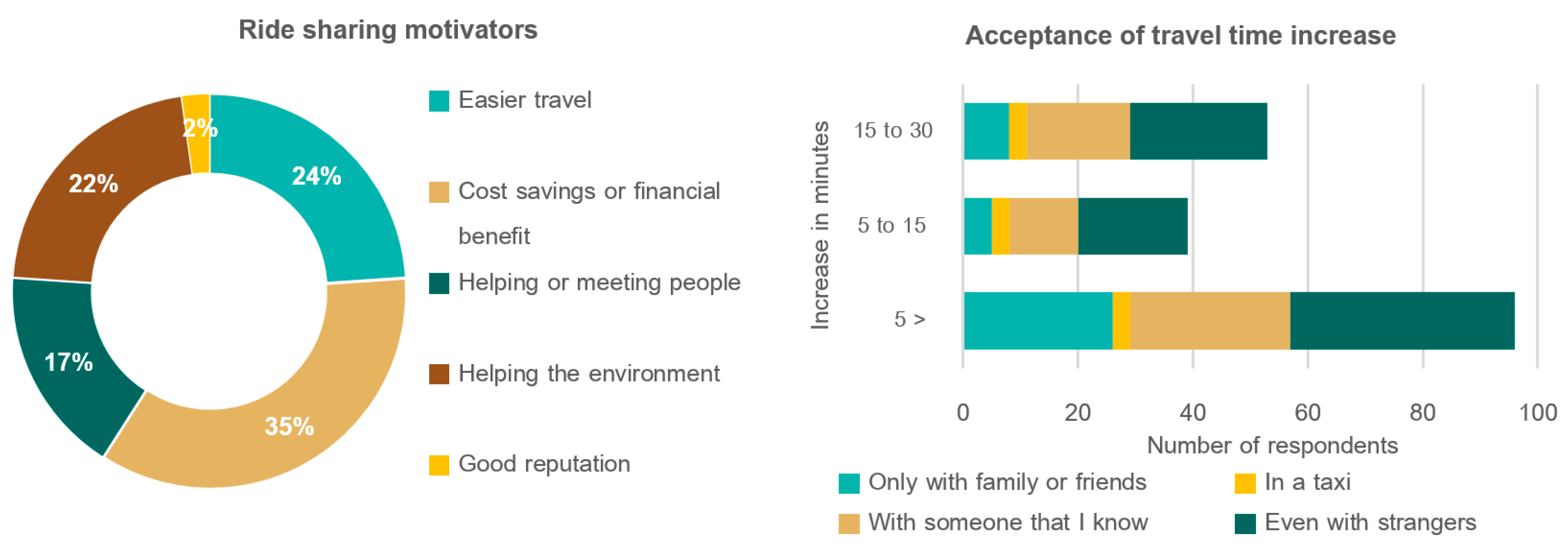
| Factors Influencing the Decision-Making on the Use of Ridesharing | ||
|---|---|---|
| Internal Factors | Psychological factors | Attitudes and preferences related to commuting |
| Attitudes and preferences related to privacy | ||
| Attitudes and preferences related to comfort | ||
| Attitudes and preferences related to social interaction | ||
| Attitudes and preferences related to protection of the environment | ||
| Preferences of a commuter regarding the driver | ||
| Social-demographic characteristics | Age | |
| Sex | ||
| Income | ||
| Marital status | ||
| Number of cars in household | ||
| Possession | ||
| External Factors | Situational factors | Accessibility of public transport |
| Price of fuel/transport costs | ||
| Commute time | ||
| Distance to the target destination | ||
| Size of the employer company | ||
| Population density | ||
| Time spent waiting for a shared ride | ||
| Interventions | Parking discounts | |
| HOV lanes | ||
| Reward programs | ||
| Partner-matching programs | ||
| Guaranteed ride home | ||
| Variable | Not Interested | Only with Family or Friends | In a Taxi | With Someone I Know | Even with Strangers | ||||||
|---|---|---|---|---|---|---|---|---|---|---|---|
| n | % | n | % | n | % | n | % | n | % | ||
| Attitudes to ridesharing | 20 | 7.2 | 52 | 18.7 | 14 | 5.0 | 92 | 33.1 | 100 | 36.0 | |
| Gender | Female | 10 | 6.7 | 31 | 20.7 | 11 | 7.3 | 49 | 32.7 | 49 | 32.7 |
| Male | 10 | 7.8 | 21 | 16.4 | 3 | 2.3 | 43 | 33.6 | 51 | 39.8 | |
| Age | 16–24 | 4 | 4.8 | 15 | 18.1 | 2 | 2.4 | 32 | 38.6 | 30 | 36.1 |
| 25–49 | 13 | 8.1 | 27 | 16.8 | 9 | 5.6 | 52 | 32.3 | 60 | 37.3 | |
| 50–64 | 2 | 7.4 | 8 | 29.6 | 3 | 11.1 | 6 | 22.2 | 8 | 29.6 | |
| 65+ | 1 | 14.3 | 2 | 28.6 | 0 | 0.0 | 2 | 28.6 | 2 | 28.6 | |
| Country of residence | Spain | 4 | 7.5 | 10 | 18.9 | 1 | 1.9 | 16 | 30.2 | 22 | 41.5 |
| Finland | 4 | 4.6 | 12 | 13.8 | 10 | 11.5 | 30 | 34.5 | 31 | 35.6 | |
| Portugal | 3 | 8.8 | 13 | 38.2 | 1 | 2.9 | 10 | 29.4 | 7 | 20.6 | |
| Slovakia | 9 | 8.7 | 17 | 16.3 | 2 | 1.9 | 36 | 34.6 | 40 | 38.5 | |
| Urban size | Small | 8 | 5.6 | 25 | 17.5 | 4 | 2.8 | 59 | 41.3 | 47 | 32.9 |
| Medium | 1 | 3.2 | 4 | 12.9 | 2 | 6.5 | 11 | 35.5 | 13 | 41.9 | |
| Metropolitan | 11 | 10.6 | 23 | 22.1 | 8 | 7.7 | 22 | 21.2 | 40 | 38.5 | |
| Marital status | Single | 9 | 5.5 | 27 | 16.6 | 5 | 3.1 | 56 | 34.4 | 66 | 40.5 |
| Married | 9 | 9.4 | 21 | 21.9 | 6 | 6.3 | 34 | 35.4 | 26 | 27.1 | |
| Civil partnership | 2 | 18.2 | 2 | 18.2 | 1 | 9.1 | 1 | 9.1 | 5 | 45.5 | |
| Divorced | 0 | 0.0 | 1 | 14.3 | 2 | 28.6 | 1 | 14.3 | 3 | 42.9 | |
| Widowed | 0 | 0.0 | 1 | 100.0 | 0 | 0.0 | 0 | 0.0 | 0 | 0.0 | |
| Number of household memberes | 1 person | 0 | 0.0 | 7 | 21.9 | 2 | 6.3 | 10 | 31.3 | 13 | 40.6 |
| 2 persons | 5 | 7.4 | 7 | 10.3 | 4 | 5.9 | 21 | 30.9 | 31 | 45.6 | |
| 3 persons | 8 | 13.8 | 11 | 19.0 | 3 | 5.2 | 13 | 22.4 | 23 | 39.7 | |
| 4 persons | 5 | 6.8 | 18 | 24.7 | 4 | 5.5 | 29 | 39.7 | 17 | 23.3 | |
| 5 persons and more | 2 | 4.3 | 9 | 19.1 | 1 | 2.1 | 19 | 40.4 | 16 | 34.0 | |
| Years of residence | Less than a year | 0 | 0.0 | 0 | 0.0 | 0 | 0.0 | 0 | 0.0 | 2 | 100.0 |
| 1 year | 0 | 0.0 | 2 | 33.3 | 0 | 0.0 | 2 | 33.3 | 2 | 33.3 | |
| 5 years and more | 20 | 7.4 | 50 | 18.5 | 14 | 5.2 | 90 | 33.3 | 96 | 35.6 | |
| Accessibility to a car | Yes | 17 | 7.8 | 46 | 21.2 | 10 | 4.6 | 79 | 36.4 | 65 | 30.0 |
| No | 3 | 4.9 | 6 | 9.8 | 4 | 6.6 | 13 | 21.3 | 35 | 57.4 | |
| Intention to Ridesharing | Productivity | Enjoyment | Health | ||||||
|---|---|---|---|---|---|---|---|---|---|
| Mean | Median | Std. Dev. | Mean | Median | St. Dev. | Mean | Median | Std. Dev. | |
| All | 48.70 | 50 | 27.988 | 70.53 | 74 | 24.480 | 54.28 | 50 | 27.160 |
| Not interested | 43.90 | 50 | 28.503 | 62.35 | 56 | 25.757 | 48.55 | 50 | 30.064 |
| Only with family or friends | 46.77 | 50 | 28.086 | 72.35 | 80 | 22.109 | 46.37 | 50 | 26.470 |
| Yes, in a taxi | 44.50 | 50 | 26.287 | 66.21 | 66 | 19.993 | 54.21 | 50 | 24.360 |
| With someone that I know | 47.86 | 50 | 27.615 | 68.63 | 70 | 21.139 | 54.59 | 50 | 23.709 |
| Even with strangers | 52.03 | 50 | 28.526 | 73.57 | 79 | 20.445 | 59.28 | 58 | 29.496 |
| Pseudo R-Square | Measures |
|---|---|
| Cox and Snell | 0.572 |
| Nagelkerke | 0.610 |
| McFadden | 0.305 |
| Intention to Adopt Ridesharing: | Only with Family or Friends | Yes, in a Taxi | Yes, with Someone that I Know | Yes, Even with Strangers | ||||
|---|---|---|---|---|---|---|---|---|
| Explantory Varibles | B | Sig. | B | Sig. | B | Sig. | B | Sig. |
| Gender (dummy) | ||||||||
| Female = 0 | −0.060 | 0.95 | −0.48 | 0.73 | 0.59 | 0.51 | 0.84 | 0.38 |
| Female = 1 | 0 | 0 | 0 | 0 | ||||
| Age (dummy) | ||||||||
| Age group (16–24) | 1.32 | 0.62 | 13.04 | 0.99 | 2.49 | 0.39 | 2.90 | 0.32 |
| Age group (25–49) | −2.42 | 0.32 | 11.09 | 0.99 | −1.41 | 0.59 | −0.75 | 0.77 |
| Age group (50–64) | −0.89 | 0.71 | 14.45 | 0.98 | −0.19 | 0.94 | 0.034 | 0.99 |
| Age group (65+) | 0 | 0 | 0 | 0 | ||||
| Number of household members (dummy) | ||||||||
| N.HH. members (1) | 9.60 | 0.97 | 8.65 | 0.97 | 8.81 | 0.97 | 9.57 | 0.97 |
| N.HH. members (2) | −3.23 | 0.04 | −1.95 | 0.39 | −2.80 | 0.08 | −2.51 | 0.12 |
| N.HH. members (3) | −4.28 | 0.01 | −3.48 | 0.16 | −4.67 | 0.00 | −4.00 | 0.02 |
| N.HH. members (4) | −2.21 | 0.18 | −0.83 | 0.71 | −2.47 | 0.13 | −3.06 | 0.06 |
| N.HH. members (5 and more) | 0 | 0 | 0 | 0 | ||||
| Urban size (dummy) | ||||||||
| Small size | −0.91 | 0.55 | −2.94 | 0.09 | 0.128 | 0.93 | −1.71 | 0.25 |
| Medium size | 4.14 | 0.05 | 1.19 | 0.64 | 5.13 | 0.01 | 4.64 | 0.02 |
| Metropolitan | 0 | 0 | 0 | 0 | ||||
| Country of residence (dummy) | ||||||||
| Spain | 1.29 | 0.47 | −2.57 | 0.33 | 1.81 | 0.31 | 0.54 | 0.75 |
| Finland | 2.52 | 0.13 | 4.15 | 0.03 | 2.80 | 0.09 | 1.82 | 0.26 |
| Portugal | 1.91 | 0.28 | −1.43 | 0.57 | 2.36 | 0.19 | −0.135 | 0.94 |
| Slovakia | 0 | 0 | 0 | 0 | ||||
| Years of residence | −11.61 | 0.00 | −2.10 | 0.99 | −11.34 | 0.000 | −12.09 | |
| Perceived value of travel time | ||||||||
| Productivity value | −0.008 | 0.69 | −0.041 | 0.11 | −0.008 | 0.68 | −0.008 | 0.67 |
| Enjoyment value | 0.074 | 0.00 | 0.089 | 0.00 | 0.068 | 0.0 | 0.082 | 0.00 |
| Fitness value | −0.030 | 0.08 | −0.001 | 0.95 | −0.015 | 0.39 | −0.011 | 0.54 |
| Trip purpose (dummy) | ||||||||
| Work trip | 3.66 | 0.03 | 3.83 | 0.04 | 4.32 | 0.01 | 3.74 | 0.02 |
| Education trip | 2.56 | 0.08 | 1.94 | 0.28 | 2.49 | 0.09 | 2.58 | 0.09 |
| Shopping trip | 0.75 | 0.68 | 2.07 | 0.31 | 1.56 | 0.39 | 1.36 | 0.45 |
| Hobby/Sport trip | −0.90 | 0.51 | −5.16 | 0.00 | −1.66 | 0.23 | −1.75 | 0.20 |
| Leisure trip | 0.33 | 0.83 | −0.60 | 0.75 | 0.19 | 0.90 | 0.29 | 0.856 |
| Time period | ||||||||
| Weekends | 4.87 | 0.00 | 5.93 | 0.00 | 4.78 | 0.007 | 5.69 | 0.001 |
| Evenings | 4.34 | 0.04 | 5.73 | 0.01 | 5.60 | 0.007 | 5.01 | 0.016 |
| Any other time | 5.41 | 0.013 | 9.11 | 0.00 | 6.38 | 0.003 | 6.07 | 0.005 |
| Perceived value of ridesharing (dummy) | ||||||||
| Easier travel | 0.69 | 0.45 | −0.61 | 0.63 | 0.80 | 0.39 | 0.22 | 0.80 |
| Economic benefit | 0.94 | 0.43 | −0.88 | 0.58 | 2.25 | 0.05 | 1.99 | 0.09 |
| Help/meet | −1.93 | 0.28 | −4.11 | 0.05 | −2.02 | 0.26 | −1.71 | 0.34 |
| Environment concerns | 1.46 | 0.32 | 2.57 | 0.13 | 0.73 | 0.61 | 1.55 | 0.28 |
| Good reputation | 6.64 | 0.98 | −4.17 | 0.99 | 6.48 | 0.98 | 7.43 | 0.98 |
| Acceptable travel time increase (dummy) | ||||||||
| 5 min or less | 0.083 | 0.94 | −0.86 | 0.55 | 6.48 | 0.98 | 7.43 | 0.88 |
| 5 to 15 min | 4.29 | 0.98 | 11.71 | 0.96 | −0.66 | 0.55 | 0.16 | 0.98 |
| 15 to 30 min | 7.15 | 0.05 | 1.39 | 0.80 | 3.91 | 0.98 | 4.04 | 0.04 |
© 2020 by the authors. Licensee MDPI, Basel, Switzerland. This article is an open access article distributed under the terms and conditions of the Creative Commons Attribution (CC BY) license (http://creativecommons.org/licenses/by/4.0/).
Share and Cite
Malichová, E.; Pourhashem, G.; Kováčiková, T.; Hudák, M. Users’ Perception of Value of Travel Time and Value of Ridesharing Impacts on Europeans’ Ridesharing Participation Intention: A Case Study Based on MoTiV European-Wide Mobility and Behavioral Pattern Dataset. Sustainability 2020, 12, 4118. https://doi.org/10.3390/su12104118
Malichová E, Pourhashem G, Kováčiková T, Hudák M. Users’ Perception of Value of Travel Time and Value of Ridesharing Impacts on Europeans’ Ridesharing Participation Intention: A Case Study Based on MoTiV European-Wide Mobility and Behavioral Pattern Dataset. Sustainability. 2020; 12(10):4118. https://doi.org/10.3390/su12104118
Chicago/Turabian StyleMalichová, Eva, Ghadir Pourhashem, Tatiana Kováčiková, and Martin Hudák. 2020. "Users’ Perception of Value of Travel Time and Value of Ridesharing Impacts on Europeans’ Ridesharing Participation Intention: A Case Study Based on MoTiV European-Wide Mobility and Behavioral Pattern Dataset" Sustainability 12, no. 10: 4118. https://doi.org/10.3390/su12104118
APA StyleMalichová, E., Pourhashem, G., Kováčiková, T., & Hudák, M. (2020). Users’ Perception of Value of Travel Time and Value of Ridesharing Impacts on Europeans’ Ridesharing Participation Intention: A Case Study Based on MoTiV European-Wide Mobility and Behavioral Pattern Dataset. Sustainability, 12(10), 4118. https://doi.org/10.3390/su12104118





